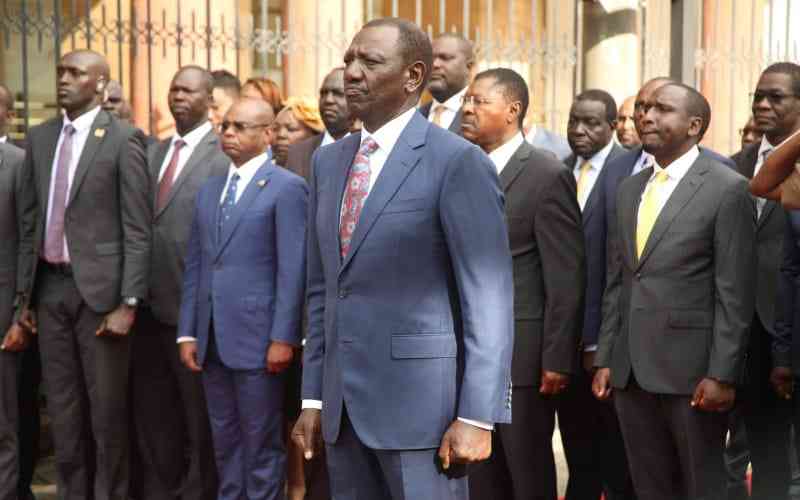By LAWRENCE KIGURO
A recent report released by the United Nations food agencies indicates that a total of 842 million people (about one in every eight people) in the world between 2011 to 2013 were estimated to be suffering from chronic hunger.
This means they are not getting enough food to enable them lead an active and healthy life.
The situation is replicated in Kenya where hunger persists, and its effects continue to impact on the lives and livelihoods of millions of people. Only about two thirds of the estimated 39 million people in Kenya are considered to be food secure.
The other third (about 10 million) suffer from chronic food insecurity and poor nutrition due to a conglomeration of factors including prolonged dry spells, unreliable rainfall, high cost of farm inputs, and the skyrocketing prices of food commodities, among others.
In 2011 the country experienced a most devastating drought. Millions endured the severe effects of the drought and had to survive on emergency relief assistance from government and humanitarian agencies.
Eradicating extreme hunger, as spelled out in the millennium development goals (MDG 1), may seem like an impossible act, but if adequate and appropriate actions are taken, a food secure nation is achievable. Measures such as relief food aid, cash transfers, food vouchers and social safety nets are critical in the immediate term to alleviate human suffering, help improve the nutrition status of young children and save lives at the height of periods of hunger.
But in the long run what these vulnerable populations need are interventions that will help cushion them from prolonged hunger, and also help them achieve long-term food security — an investment that will pay off in the future, guaranteeing better educated, stronger and healthier adults.
The country should learn from the 2011 drought, described as the worst ever, by implementing policies to effectively tackle hunger and malnutrition.
In 2012, Kenya launched the national food and nutrition security policy, which stipulates policies and strategies aimed at addressing chronic hunger and malnutrition currently affecting millions of citizens.
The government and development agencies implementing food and nutrition programmes must therefore use the policy to guide the roll out of food security and nutrition interventions that will help reduce incidences of extreme hunger and malnutrition across the country.
World Vision, for example, is promoting the use of Zai pits technology in Mutonguni in eastern Kenya. This technology enhances water conservation on the farm for direct use by the crops, and controls soil erosion in addition to conserving nutrients.
It is able to increase yields by up to four times compared to the conventional method of farming. Other areas such as Mtito Andei are now boasting of food security after farmers were trained and encouraged to employ this farming method.
Since agriculture remains the main source of livelihood for the majority of the rural poor, the need to ensure that smallholder farmers, especially the women, have access to knowledge, information, financial services, farm inputs and access to markets is not only necessary but urgent.
This will go a long way in demonstrating that those prone to drought and food insecurity do not perpetually need to depend on external generosity to survive, but instead can produce their own food.
Stay informed. Subscribe to our newsletter
Disasters are inevitable therefore populations must be equipped to manage them so that they are able to mitigate impact of drought. There is satisfaction when these families have the resilience that will protect them from external shocks both big and small when disasters of whatever nature occur.
Again, food programme interventions should be “nutrition-sensitive” in order to address and reduce various forms of malnutrition.
For example, promoting crop diversification and providing nutrition education especially to women is important. Knowledge that reducing hunger is not only increasing the quantity of food, but also about increasing the quality of food in terms of diversity, nutrient content and safety becomes essential.
This calls for adoption of nutrition sensitive interventions that will not only address issues of hunger but also combat malnutrition through integrating nutrition activities into agriculture.
Today, the world marks World Food Day, a moment dedicated to raising awareness of the issues behind poverty and hunger.
This day should serve as a reminder of the need to embrace a holistic approach that focuses on protecting children and communities from the looming threat of hunger and malnutrition.
The author is the Associate Director, Livelihoods and Resilience at World Vision Kenya
 The Standard Group Plc is a
multi-media organization with investments in media platforms spanning newspaper
print operations, television, radio broadcasting, digital and online services. The
Standard Group is recognized as a leading multi-media house in Kenya with a key
influence in matters of national and international interest.
The Standard Group Plc is a
multi-media organization with investments in media platforms spanning newspaper
print operations, television, radio broadcasting, digital and online services. The
Standard Group is recognized as a leading multi-media house in Kenya with a key
influence in matters of national and international interest.
 The Standard Group Plc is a
multi-media organization with investments in media platforms spanning newspaper
print operations, television, radio broadcasting, digital and online services. The
Standard Group is recognized as a leading multi-media house in Kenya with a key
influence in matters of national and international interest.
The Standard Group Plc is a
multi-media organization with investments in media platforms spanning newspaper
print operations, television, radio broadcasting, digital and online services. The
Standard Group is recognized as a leading multi-media house in Kenya with a key
influence in matters of national and international interest.








